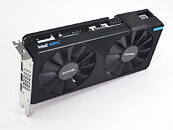Thursday, August 4th 2022

Intel Arc Board Partners are Reportedly Stopping Production, Encountering Quality Issues
According to sources close to Igor Wallossek from Igor's lab, Intel's upcoming Arc Alchemist discrete graphics card lineup is in trouble. As the anonymous sources state, certain add-in board (AIB) partners are having difficulty adopting the third GPU manufacturer into their offerings. As we learn, AIBs are sitting on a pile of NVIDIA and AMD GPUs. This pile is decreasing in price daily and losing value, so it needs to be moved quickly. Secondly, Intel is reportedly suggesting AIBs ship cards to OEMs and system integrators to start the market spread of the new Arc dGPUs. This business model is inherently lower margin compared to selling GPUs directly to consumers.
Last but not least, it is reported that at least one major AIB is stopping the production of custom Arc GPUs due to quality concerns. What this means is yet to be uncovered, and we have to wait and see which AIB (or AIBs) is stepping out of the game. All of this suggests that the new GPU lineup is on the verge of extinction, even before it has launched. However, we are sure that the market will adapt and make a case for the third GPU maker. Of course, these predictions should be taken with a grain of salt, and we await more information to confirm those issues.
Source:
Igor's Lab
Last but not least, it is reported that at least one major AIB is stopping the production of custom Arc GPUs due to quality concerns. What this means is yet to be uncovered, and we have to wait and see which AIB (or AIBs) is stepping out of the game. All of this suggests that the new GPU lineup is on the verge of extinction, even before it has launched. However, we are sure that the market will adapt and make a case for the third GPU maker. Of course, these predictions should be taken with a grain of salt, and we await more information to confirm those issues.

133 Comments on Intel Arc Board Partners are Reportedly Stopping Production, Encountering Quality Issues
idk man, they are trading blows and are otherwise 1 to 2 frames apart...they are the same and that has always been the consensus.
But ultimately this is a rather silly back and forth, it does not hurt anything or anyone, it does not help anything or anyone :p
Ultimately though they could have still released these against the next gen AMD/Nvidia and they still would sell ok providing the price is right, the cards would be weaker, less efficient, but if the value is there then those things would be overlooked by the budget crowd. Seems to be a combination of greed and impatience from Intel, writing drivers from complete scratch is no easy task.
The reason why GTX 1060 outperformed RX 480 while the latter was much stronger "on paper" (~50%) has nothing to do with a node advantage, it's the result of better resource management. RX 480's power draw was the result of AMD using "brute force" to throw resources at the problem, while Nvidia used better GPU scheduling to use less GPU resources per rendered frame. Better resource control also means less chances of stalls, either small or large, which is what happens when you see a single frame take too long. AMD have since gotten better, but interestingly enough, Intel is facing basically the same problem with Alchemist; a GPU with a lot of (theoretical) power, which scores decently in synthetic workloads, but poorly in games and especially with frame rate consistency at higher frame rates. This is a GPU scheduling issue, and no amount of driver wizardry can compensate for that.
www.techpowerup.com/gpu-specs/radeon-rx-480.c2848
see the relative performance
Apparently the numbers from 3 written sources are wrong and we're down to Youtube level now to mitigate the damage, after 'Userbenchmark is wrong, use TPU, and it showing another 10% gap in the very review of the product'. I'm out of this one ;) Be sure to polish those glasses once in a while though.
Back to your first link: the averages aren't far apart to begin with (4% is not uncommon!), I specified the 1% lows from the get-go and its a common theme with GCN-based GPUs. Irrespective of driver versions, as the 390X does the same thing as linked before.
But again - you do your version on whatever numbers suits yours, I'll base mine on the facts and specifics until some written test proves otherwise. I haven't seen any and I'm insensitive to user sentiment.Yeah, I assumed something of the sort. Thanks for clarifying.
And sure, the node advantage applies mostly to efficiency, not so much performance.